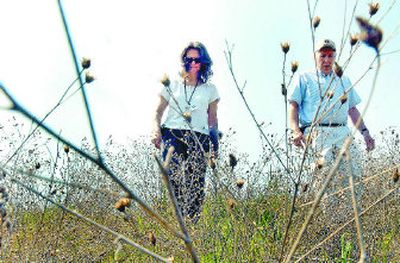It’s prime time in noxious-weed war

BOISE – It’s noxious weed season, and a new Idaho law has put a lot more teeth into enforcement.
But the basic premise of Idaho’s weed law hasn’t changed: The property owner is responsible. Whether there’s spotted knapweed or flowery Dalmatian toadflax sprouting in an untended backyard, or orange hawkweed, with its cheery, daisylike flowers, taking over entire meadows, the landowner has to put a stop to it.
If owners refuse to act, they could face fines of up to $10,000. But officials say such fines are unlikely – and the bigger point is to help landowners understand how big a problem noxious weeds can pose and how to combat them.
“They replace the native plants and they render valuable land useless – they choke out the plants that wildlife eat, they starve them out of their areas and make them move to different areas,” said Roger Batt, statewide coordinator of the Idaho Weed Awareness Campaign. “This costs Idaho approximately $300 million a year to combat this issue,” he said, including federal, state, local government and private landowner efforts.
Spotted knapweed, among the most common noxious weeds in North Idaho, secretes an herbicide that kills nearby vegetation.
“Throughout the state we have 57 different weeds that are on the noxious weed list. We don’t have all 57 of them in our area, but we have enough of them to keep us all busy,” said Nina Eckberg, Kootenai County weed supervisor and chairwoman of the Inland Empire Cooperative Weed Management Area.
This is the time of year when landowners have the best shot at killing off noxious weeds.
“They’re the first plants that are usually emerging as the snow starts to recede from the mountains,” Batt said. “At this stage, you can kill the plant – it’s actually at its weakest point.”
In the early growth “rosette” stage, the newly emerged weeds can be “very easy to get rid of with a hoe or a shovel – or if you spray it, it’ll certainly die,” he said.
That’s not the case with full-grown weeds. Some, like leafy spurge, develop root systems that can spread 30 feet. Spotted knapweed produces 25,000 seeds per plant, which are dispersed by wind and capable of producing new plants for eight years.
Eckberg doesn’t expect to be levying a lot of fines in Kootenai County. She remembers going to enforcement three times in the past four years. Those involved having the county remove the weeds and bill the landowner, filing a lien if he or she refused to pay.
“I really try to work with the landowner,” Eckberg said, “let them understand that there is a law, and here’s the reason why you want to control these particular weeds.”
Spotted knapweed, for example, contains a toxin that can cause disease in the mouths of elk, deer or horses that eat the plant.
Eckberg said noxious weeds can be managed by pulling or tilling, by planting more desirable plants and fertilizing, by mowing, or by chemicals, depending on the situation. She encouraged anyone with questions about how to get rid of weeds to contact their local county weed supervisor – every Idaho county has one. Her office has seen a sharp uptick in contacts from the public, with more than 17,500 last year, up from 10,000 two years ago.
Her office also lends landowners sprayers and other equipment to help them curb weeds.
Spring and fall are the best times for chemical applications, she said. When it rains, the soft ground is ideal for pulling and digging out noxious weeds.
Batt said the best thing Idaho landowners can do is “not pick and pull and replant pretty flowers you might see on the landscapes,” and learn how to identify the plants.
He recommends a University of Idaho noxious weed guide that’s available for free through the Weed Awareness Campaign’s Web site, www.idahoweedawareness.org.
Eckberg said increased attention in recent years to the highly invasive aquatic weed Eurasian milfoil has helped raise awareness of terrestrial noxious weeds, too. Idaho passed its stricter enforcement law and other updates to the noxious weed law in 2006, but regulations implementing the changes just cleared the Legislature this year and went into effect this spring. Lawmakers this year also approved $10 million to combat noxious weeds over the next two years, with about half of that going to fight milfoil.
Matt Voile, noxious weeds section manager for the state Department of Agriculture, said, “You can only dictate through law and policy and rule a certain amount. The success of the program only comes from the concerned citizenry of the state taking action on their own piece of property.”